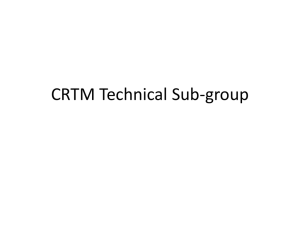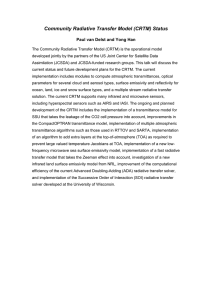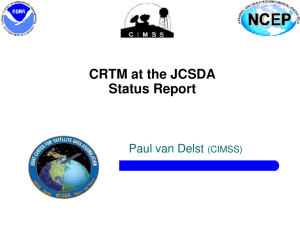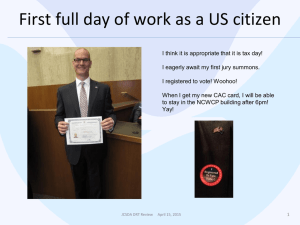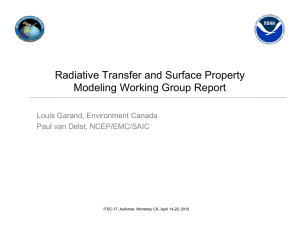CRTM Technical Sub-Group Report Paul van Delst, NCEP/EMC/SAIC
advertisement
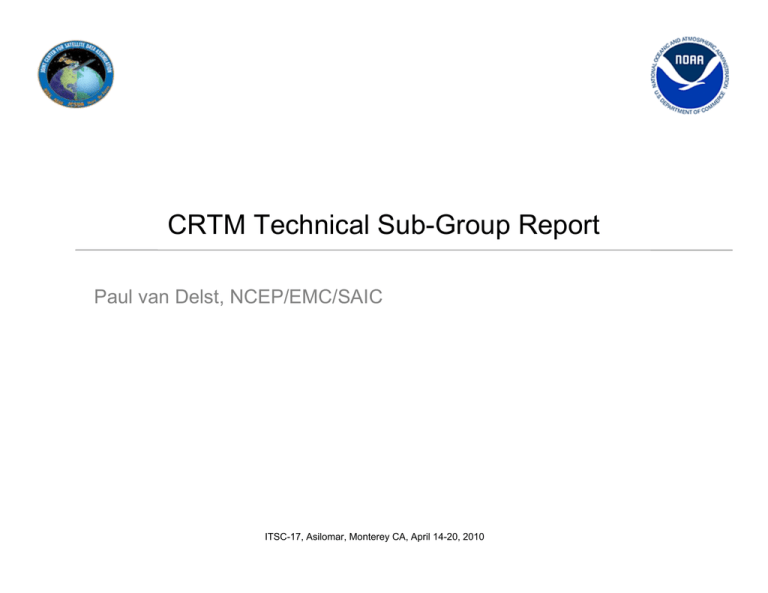
CRTM Technical Sub-Group Report Paul van Delst, NCEP/EMC/SAIC ITSC-17, Asilomar, Monterey CA, April 14-20, 2010 CRTM 2.0 Released (1) • Version 2.0 of the CRTM released March 12, 2010. Available at ftp://ftp.emc.ncep.noaa.gov/jcsda/CRTM/REL-2.0 • The 2.0 User Guide is also available there ftp://ftp.emc.ncep.noaa.gov/jcsda/CRTM/CRTM_User_Guide.pdf • Email address for CRTM Support: NCEP.List.EMC.JCSDA_CRTM.Support@noaa.gov • Many people at the JCSDA (and EMC and STAR) have been involved in the update, but special mention must be made of – Yong Han (NESDIS/STAR) – Quanhua Liu (NESDIS/STAR/Dell Perot) – Yong Chen (NESDIS/NESDIS/CIRA) for their efforts in implementing and testing all the new science features. ITSC-17, Asilomar, Monterey CA, April 14-20, 2010 CRTM 2.0 Released (2) Yong Han’s talk details the CRTM 2.0 updates. Briefly: • New Science – – – – – – – • Multiple transmittance models, including SSU-specific model. Zeeman-splitting transmittance for SSMIS upper-level channels Visible sensor capability Matrix operator method (MOM) in radiative transfer Additional IR sea surface emissivities developed by Nick Nalli (see poster) Surface BRDF for solar affected shortwave IR channels IR reflectivity over water changed from Lambertian to specular Interface changes – Initialisation function – User accessible structure definitions use Fortran2003 features to mitigate memory leakage problems. To delineate this change from previous versions of the CRTM the various structure procedures have been renamed. – Options structure specific changes to accommodate input for new features (e.g. SSU, Zeeman, etc) ITSC-17, Asilomar, Monterey CA, April 14-20, 2010 CRTM 2.0.1 (!) • • To address various issues with the 2.0 release, we’re targeting end of April for a minor update, REL-2.0.1 No changes will be made that alter results. Only minor fixes made (e.g. makefiles, error messages, example code, address compiler bugs, etc). ITSC-17, Asilomar, Monterey CA, April 14-20, 2010 CRTM 2.1 • The next update to CRTM science is targeted for a July 2010 release. • Currently planned updates: – FASTEM-4 (Q. Liu at JCSDA) – SOI radiative transfer algorithm (T. Greenwald at CIMSS/SSEC/UWisc) • Possible updates: – Implementation of new IR land surface emissivity models. • • GrELS UW HSR These are currently being tested in the data assimilation system at NCEP/JCSDA. ITSC-17, Asilomar, Monterey CA, April 14-20, 2010 CRTM Version Control and SCM • In Feb2009 EMC’s “public” version control and SCM server came online. This has proved invaluable for managing the software changes from multiple sources/branches – development is now much faster. ITSC-17, Asilomar, Monterey CA, April 14-20, 2010 LBL model updates • We (JCSDA) plan to completely recompute transmittances for all sensors this summer using latest LBLRTM (infrared) and MonoRTM (microwave). • We have been working on a new spectral response function (SRF) data format to accommodate data from microwave sensors (ATMS and SSMIS). • We are refactoring our transmittance production software to make these database calculations more “turnkey” (currently needs a lot of babysitting). • JCSDA has a very productive collaboration with AER, Inc. as the source of LBL software and updates….. ITSC-17, Asilomar, Monterey CA, April 14-20, 2010 Consistency across Mid-infrared Spectral Regions LBLRTM Mean residuals from 36 ARM TWP cases using Tobin et al. best estimate sonde profiles. Profile inputs from AIRS Phase I val. supplied by L. Strow and S. Hannon (UMBC). CO2 line coupling Application of Niro et al. (2005) H2O line positions and strengths Coudert et al. (2008) Example AIRS spectrum Older lblrtm version CO2 line positions and strengths Tashkun et al., (1999) Already in use by MIPAS team (Flaud et al., 2003) v11.6 lblrtm release H2O shifts, Tdep. Of widths Gamache (personal comm.) CO2/H2O continuum V11.7 beta version (see final LBLRTM v11.7 release) -8- Significant improvements to consistency between spectral regions! V11.7 - IASI comparisons (CO22 ν3 band head) CO2 continuum scaled to fit IASI observations in dry conditions (PW < 0.65 cm) Dependence of residuals on temperature/water vapor reduced by: 1) Including temperature dependence of CO2 continuum (based on line coupling coefficients at 200K, 250K and 340K in addition to 296K) 2) Scaling of H2O self broadened continuum by a factor up to 5-7 -9- LBLRTM v11.7 LBLRTM v11.6 LBLRTM v11.7 LBLRTM v11.6 LBLRTM v11.7 LBLRTM v11.6 LBLRTM: future plans NLTE: Added flexibility to accept user specified isotopes and NLTE bands (hard coded in current release) in special JCSDA release Future: Test with larger set of IASI/RAOB match ups and adjust atmospheric profiles using the radiometric measurements in selected spectral regions CO2 667 cm-1 Q-branch (treatment of line coupling) CH4 line coupling H2O ν2: Line widths (R. Gamache, U. Mass Lowell) Local continuum adjustment HITRAN 2008 evaluation - 10 - MonoRTM updates (summary) Water vapor continuum in microwave region recently updated (Payne et al. 2010) based on measurements from multiple ground based radiometers and well-colocated radiosonde measurements at ASR (ARM) SGP, NSA, COPS (FKB) sites Agreement with new, independently readjusted, RSS continuum at 37 and 89 GHz is now quite good (RSS model not valid above 89 GHz) 5% difference in the 22GHz line width used in MonoRTM and in Rosenkranz and RSS models (affecting mainly interpretation of SSM/I and SSMIS measurements) remain unexplained. MonoRTM line width validated at ARM sites (Payne et al., IEEE TGRS2008) - 11 -
